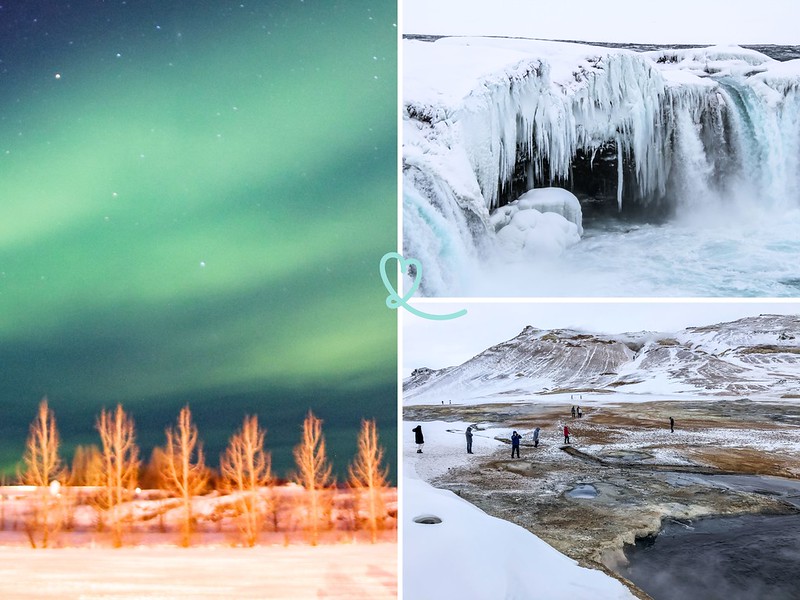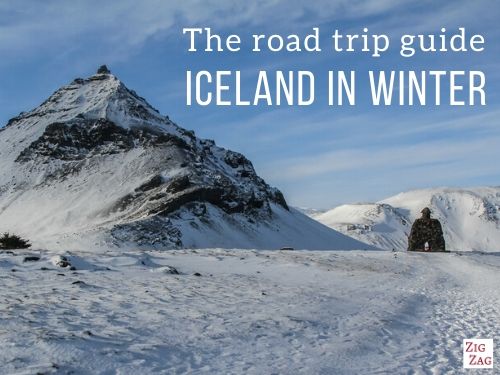North Iceland’s winter landscape is breathtakingly beautiful, with frozen waterfalls, northern lights and steaming hot springs. We were won over by this authentic region, which offers a polar experience far from the beaten track of the south of the island. The snow-capped fjords of Akureyri, the geothermal formations of Mývatn and the historic sites of Húsavík make up an exceptional winter tableau that turns every outing into a memorable adventure.
This season reveals the wild character of northern Iceland in a whole new light, where the natural elements sculpt enchanting settings you won’t forget.

This opinion is completely independent, based on our experiences. We visited the region anonymously, making our own choices and paying our bills in full.
Content
Is Northern Iceland worth a visit in winter?
Northern Iceland is well worth a visit in winter. We were won over by its snowy landscapes, spectacular northern lights and steaming hot springs. This authentic region offers a unique polar experience, far from the crowds of the south of the island.
Practical advice
No specific advice for North Iceland in winter compared to the rest of Iceland.
Normally, the roads are cleared quickly enough for access. But during snowstorms, roads may be closed at the last minute – always check the road status on Umferdin.
- How much time should I allow?
At the very least 3 days, but you can easily occupy yourself for 1 week.

North Iceland or South Iceland in winter?
The south offers more impressive waterfalls and contrasting landscapes. The region is most visited in winter.
But we also loved the north for its absolute calm. The uniformly white backdrops create a unique, almost unreal atmosphere, giving the impression of being in another world, far removed from the crowds of the classic circuit.
More tips in our article.

1. Whale watching in Husavik or Akureyri
Iceland is a top destination for whale watching, with over 20 species present in its waters. Boat excursions bring you close to these magnificent marine mammals, as well as to dolphins and porpoises.
Although summer is the best period, some species can be seen in winter. If you’re passionate about these giants of the seas.
>> See Akureyri excursion options
>> See Husavik excursion options

2. Chasing the northern lights
To admire the northern lights, winter is the best time to visit Iceland. The long, dark nights offer ideal conditions for observing this unique celestial spectacle.
Northern Iceland is often considered the best region for viewing the Northern Lights, as it is further north and often has clearer skies.
Clear skies and high solar activity 18 hours beforehand are required without guarantee. Many hotels offer wake-up calls in the event of visible dawn, so you don’t miss a thing.
Admiring the dancing colors of the Northern Lights is an unforgettable experience, all the more so in Iceland where you can combine these nocturnal excursions with exploring the breathtaking landscapes during the day. No time to get bored!
Between October and April, the chances of catching a glimpse of this natural phenomenon are at their highest, and guided tours are a must in winter.
>> Find out more in our article on the aurora borealis (coming soon).
Or take a look at the different tour options

WHERE TO STAY IN Iceland
Our independent picks for the accommodation of your dreams:
- Where to stay in Iceland (coming soon)
- Where to sleep in Reykjavik (coming soon)
- Best 5-star hotels (coming soon)
- Where to sleep on the South Coast (coming soon)
- Where to sleep on the Golden Circle (coming soon)
- Where to sleep on the Snaefellsnes peninsula

3. Dimmuborgir

Why visit?
At Dimmuborgir, the snow-covered lava formations create a magical landscape, especially if the sky is white too! Although some of the trails are difficult, the main area remains accessible.
Scientists believe that around 2,300 years ago, a lava tube formed above a lake. It trapped the water in a reservoir around 10 m deep.
As the lava began to cool, the reservoir was released, leaving only the shapes created by the steam.
We loved the black-and-white landscape, where you can let your imagination run wild.

Practical advice
- Around Lake Myvatn
- From Akureyri: 1h20 if running smoothly
- Allow 45min to 1h to explore and enjoy the most accessible part.
- Bring crampons
- Restaurant closed in the dead of winter
- Free access
Find out more in our dedicated article.
RENTING A CAR IN Iceland
Discover the best offers on Discovercars, our preferred platform!
On Route 1, no 4WD required, off Route 1, it depends on your plans.

4. Hverir

Why visit?
Hverir is a geothermal zone that remains easily accessible in winter. It offers a unique, otherworldly landscape, even in cold weather. You’ll be amazed by the contrast between the bubbling mud pools, steam vents and sulfur deposits and the perfect white of the snow.

Practical advice
- Around Lake Myvatn
- From Akureyri: 1h20 if running smoothly
- Allow 30min to 1h
- Pay parking
- No installations
- Respect the marked trails to avoid melting your shoes!
Find out more in our dedicated article.
5. Myvatn Nature Baths

Why visit?
Visiting Myvatn’s natural baths in winter is a unique and enchanting experience.
The contrast between the steaming geothermal waters and the surrounding snow-covered landscape creates a magical, relaxing atmosphere.
It’s true that cooler air temperatures make hot water even more attractive. And the steam rising from the surface adds to the atmosphere! It’s ideal at the end of a long day exploring and walking in the snow.
More tips in our dedicated article.

Practical advice
- Around Lake Myvatn
- From Akureyri: 1h20 if running smoothly
- Allow at least 1 hour
- 1km detour from Route 1
- Easy access
- Building restoration
OUR GUIDE TO PLANNING A Dream trip
- 6 maps that make planning easier
- + 75 pre-selected locations
- Practical advice
- + 115 photos to help you choose

6. Skutustadir

Why visit?
Skutustadir is an area of Lake Myvatn with several pseudo-craters. Only part of the trail is accessible in winter, but the calm, frozen landscapes seem quite surreal.
Make no mistake, these are not real volcanic craters!
The theory is that these pseudo-craters were formed around 2,300 years ago, by steam explosions as hot lava flows over wet sediments or frozen ground. It’s a fairly rare phenomenon, and experts believe it also occurs on Mars.
In any case, we enjoyed climbing up one of them to admire the scenery.

Practical advice
- Around Lake Myvatn
- From Akureyri: 1h20 if running smoothly
- Allow 1 hour
- Wear crampons to walk safely on the trail
- Restaurant at the hotel across the road
- Free access
Find out more in our dedicated article.
7. Godafoss in winter

Why we love it
In winter, the Godafoss waterfall is one of the most enchanting, in our opinion.
As the river continues to flow, parts of the waterfall are frozen solid, forming stalactites in white and blue.
The surrounding area is covered in snow, creating a striking contrast with the rushing glacial waters.
Access and useful tips
- On Route 1 between Akureyri and Lake Myvatn
- From Akureyri: 40min if running smoothly
- From Lake Myvatn = 50min drive
- 10min walk along the river to admire the different viewpoints.
- Petrol station with snack bar
- It’s a great place to see the northern lights.
Subscribe to our Newsletter
- Get away from it all with Region Lovers’ beautiful destinations!
- Once a month
- Advertising-free
8. Akureyri in winter

Why visit?
Nicknamed the “Capital of the North”, Akureyri reveals its special charm in winter, with its colorful houses contrasting against the immaculate snow. We enjoyed the warm atmosphere of this compact city, nestled at the head of the Eyjafjörður fjord, which offers a perfect balance between urban culture and wilderness.
Akureyri’s botanical gardens, surprising under their snowy mantle, testify to the relative mildness of the local climate.

Practical advice
- Duration: 1 to 2 days to visit the city and surrounding area
- Difficulties: Sloping streets can be slippery in winter, so bring good non-slip shoes.
- Access: Akureyri airport with domestic flights from Reykjavik, or a 4.5-hour drive from the capital via the ring road.
9. Husavik

Why visit?
Húsavík, nicknamed “Europe’s whale-watching capital”, offers a completely different but equally captivating experience in winter. A charming little fishing port with a population of 2,300. Local life unfolds at a peaceful pace, far from the hustle and bustle of summer.
Winter transforms this destination into a haven of peace, where colorful houses stand out against the white landscape. Here you’ll discover the fascinating Whale Museum, one of the most comprehensive collections in Europe, and the wooden church of Húsavíkurkirkja, majestically overlooking the snow-covered bay.
Practical advice
- Duration: 1 day for the city
- Difficulty: Easy city exploration. Access to surrounding natural sites may be difficult in bad weather, roads may be closed
- Access: 1h drive from Akureyri via route 85, or 5h30 from Reykjavik
- Eating and drinking: A few restaurants and cafés in the center, especially near the port
- Whale Museum, church, port… and whale watching!
10. Snow activities around Myvatn
Of course, you can also enjoy experiences that can only be enjoyed in winter when the landscape is covered in snow!
Here are some suggestions:
- Dog sledding excursion – see details and availability
- Snowmobile excursion – see details and availability
- Snowshoe hikes – see details and availability
And see our other favorite winter spots in Myvatn.

PLAN YOUR TRIP TO iceland IN WINTER
- Best of
Iceland’s winter landscapes
Best things to do in Iceland in winter
The most beautiful waterfalls
Ice caves
Best excursions from Reykjavik

- Practical advice
Getting around (coming soon)
How to rent a car in Iceland
Winter driving tips
Where to stay in Iceland in winter
Itineraries: 3 days – 4 days – 5 days – 1 week – 10 days (to come)

- The must-dos
Reykjavik in winter
Golden Circle in winter
South coast in winter
Snaefellsnes in winter
Silver Circle in winter (coming soon)
Lake Myvatn in winter
Eastern Fjords in winter
Seljalandsfoss in winter
Jokulsarlon in winter




